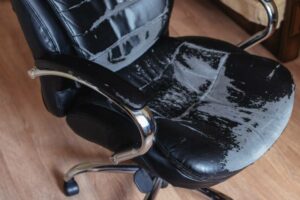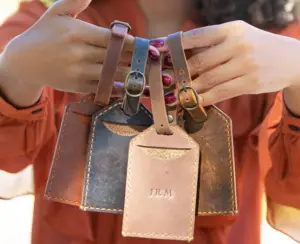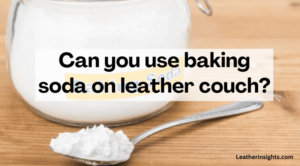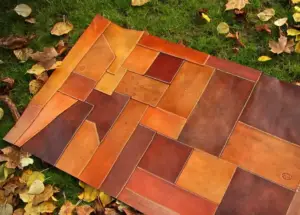7 Leather damage types, causes and repair
Leather is a natural material that is durable and tough wearing but it is susceptible to damage by various causes. So, what causes leather damage?
Leather products can fade, stain, discolor, tear, scratch, peel or crack due to a number of factors, including physical stress, exposure to sunlight, excess heat, and improper storage or cleaning.
Fortunately, there are ways to protect the leather and keep it in good condition for years.
In this article, we will look at things that can ruin leather so that you can learn how to fix and repair various types of leather damage.

Types of leather damage and their causes
The most common types of leather damage include fading, discoloring, scratches and scuff marks, peeling and cracking, tears, mold and mildew, and staining.
1. Fading
Leather tends to fade when exposed to sunlight over a prolonged period of time.
The sun’s ultraviolet (UV) rays can cause the fibers in the leather to break down, leading to cracking, drying, and fading.
In extreme cases, exposure to the sun can cause the leather to become brittle and crumble.
If you own leather items, it is important to take steps to protect them from sun damage.
You can do this by storing them in a cool or by using a leather conditioner to help keep the material hydrated. You should also avoid exposing the leather to direct sunlight.
2. Discolored leather
Leather is a porous material that may absorb spills and dirt easily. If not cleaned properly, your leather items may stain and become discolored as we saw in this article.
Harsh chemicals can also ruin leather, making it more susceptible to staining and tearing.
So it’s important to clean leather using the right products because harsh chemicals can dry it out, discolor it, and even break down the protective finish on the surface.
3. Cracking
Leather should not be exposed to high heat as this can cause damage. For instance, steaming leather can cause it to become stiff and brittle and eventually crack and break.
This is because the high temperature causes leather to lose its natural oils and this dries it out.
To prevent heat damage, do not dry your leather garments in the dryer.
Also, avoid placing your furniture near the heating vent in the house. You should also not use a hair dryer to dry wet leather.
4. Moldy leather
Water and moisture are enemies of leather. When leather gets wet, it creates a favorable environment for the growth of mold and mildew, which can lead to more serious damage.
According to research by The Forensic Experts Group “The moldy belt was found to be degraded by humidity and fungal attack, resulting in loss of tensile strength and tear resistance”.
If you have moisture-damaged leather, it’s important to act quickly.
The sooner you start the drying and cleaning process, the better your chances of saving your leather pieces.
However, the best way to protect your leather is to keep it away from moisture and water.
5. Scratches, scuff marks, and tears
It’s important to avoid using sharp objects on leather products because they can cause severe damage.
Sharp objects like belt buckles, forks, knives, scissors, or any sharp-edged material can easily puncture your leather furniture or clothing.
They can also leave unsightly scuffs and scratches that can be difficult to repair.
Also, consider trimming your pet’s nails and claws since they can also scratch your leather items accidentally.
6. Stains
One of the main causes of leather stains is dye transfer. It is particularly an issue if you have a bright-colored leather product.
It occurs when colored clothes or fabric rub against the leather causing the dye to bleed on it.
If the dye is not wiped off immediately, it permeates through the leather pores into the fibers causing staining.
The color stains are usually tough to remove and may require a suitable leather stain remover.
Also, if your leather item is always in close contact with your skin, like a couch, jacket or skirt, body oils and sweat can damage it.
A buildup of sweat and body oil can penetrate through the pores of the leather and cause significant damage.
The sweat stains the leather and strips off the finish while the oil gets absorbed into the leather and reacts with the tannins, which causes discoloration.
How to fix and repair damaged leather
-
Leather repair filler
Medium to deep cracks, holes, tears, burns, scratches and rips on leather can be repaired using a leather filler and dye.
Leather filler is also known as a leather repair compound. It is simply a flexible paste consisting of PVA glue that is mixed with leather paint or leather finish.
The filler completely seals the cracks and scratches by creating a bond with the leather surface. It dries quite fast and can be used along with a dye colorant to match the color of the leather surface.
More so, leather fillers come in different colors so you can choose one that matches your leather product in order to attain a seamless look.
-
Leather repair patch
A leather repair patch is simply an adhesive-backed piece of leather that can be used to repair cracks, scratches, and tears on sofas, chairs, and car seats.
To use it, measure and cut the leather patch into the size and shape you want according to the defect on your leather item.
Peel and stick the patch over the damaged surface and leave it for about 24 hours for the adhesive to adhere strongly.
Note that when buying a leather patch; choose a color that matches your leather product so that you can get a seamless look after repair.
-
Color restoration kit
A leather color restoration kit is used to restore the color of faded or discolored leather. You can also use it to fix minor peeling and scuff marks on your leather items.
Recoloring only takes a few hours as long as you’ve got all the items needed. You can purchase the restoration kit from a physical store near you or online.
If you are wondering which repair kit is best, consider using Fortivo Leather and Vinyl Repair Kit. It is affordable and covers stains, scratches, and tiny holes seamlessly.
However, instead of spot treatment, you should apply the color restorer to the entire piece of leather furniture or garment.
-
Leather cream or conditioner
Water-damaged leather tends to dry out and crack if not well moisturized for a long time. So to repair dried-out leather, consider applying a suitable leather cream or conditioner.
The leather conditioner simply moisturizes the leather items while the cream moisturizes as well as polishes and restores color to leather that has minor scratches.
Also, the cream gives your leather a good shine when buffed.
-
Regular cleaning and maintenance
Leather is a natural product as such; it needs to be treated with care especially when it comes to cleaning.
Dirt, dust, grease, and body oils often affect the appearance of leather items by causing stains that lead to a change of color. This is why regular cleaning and maintenance are recommended.
When cleaning, always use mild soap like dove soap on leather and avoid harsh and abrasive chemicals like can cause further damage.
Professional cleaning is also recommended occasionally to get rid of stubborn stains.
Conclusion
There are many reasons why leather can become damaged and ruined. Some of the most common causes include exposing leather to too much sunlight, water, and moisture, body oils, and sweat, sharp objects, improper cleaning, and physical stress that can result in wear and tear.
To avoid ruining your leather accessories and items, consider the following;
- Cleaning your leather products regularly using the right cleaning products
- Avoid exposing the leather to direct sunlight
- Keep clothing like jackets and boots away leather from rain, water, and moisture
- Avoid using heat to dry leather or storing items in a hot place.
- Trim your pets’ paws and claws often
- Keep sharp objects away from your leather products
Citation:
The Forensic Experts Group. (2002) Causes of damage to leather products. Available at http://www.forensicexperts.com.sg/causes-damage-leather-products





